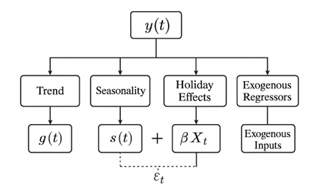Prophet with Exogenous Variables for Procurement Demand Prediction under Market Volatility
DOI:
https://doi.org/10.70393/6a6374616d.333237ARK:
https://n2t.net/ark:/40704/JCTAM.v2n6a03Disciplines:
Big Data TechnologySubjects:
Data AnalyticsReferences:
5Keywords:
Prophet Model, Exogenous Variables, Market Volatility, Procurement Demand ForecastingAbstract
Addressing the issue of insufficient accuracy in procurement demand forecasting under market volatility, this study investigates the Prophet model with exogenous variables. It outlines the comprehensive workflow encompassing data preprocessing, feature reconstruction, and model training, while introducing trend decomposition and forecasting implementation methods constrained by multi-source features. Comparative experimental results demonstrate that the improved model reduces RMSE by 21.5% and MAPE by 34.2% in high-volatility intervals, significantly enhancing prediction stability. This validates the effective corrective role of exogenous variables in addressing complex market disturbances.
References
[1] Kang, M. (2025). Research on prediction model and optimization of enterprise material procurement management based on global linkage. International Journal of Computational Intelligence Systems, 18(1), 242.
[2] Kao, C., Liu, L., & Sun, R. (2025). A bias-corrected fixed effects estimator for the dynamic panel data model with exogenous variables. Economics Letters, 254, 112426.
[3] Setiawan, S., Sohibien, D. P. G., Prastyo, D. D., et al. (2024). Addition of subset and dummy variables in the threshold spatial vector autoregressive with exogenous variables model to forecast inflation and money outflow. Economies, 12(12), 352.
[4] Sel, B., & Minner, S. (2025). Probabilistic forecast-based procurement in seaborne forward freight markets under demand and price uncertainty. Transportation Research Part E, 193, 103830.
[5] Huang, Z., & Ma, Z. (2024). Remaining useful life prediction of lithium-ion batteries based on autoregression with exogenous variables model. Reliability Engineering and System Safety, 252, 110485.

Downloads
Published
How to Cite
Issue
Section
ARK
License
Copyright (c) 2025 The author retains copyright and grants the journal the right of first publication.

This work is licensed under a Creative Commons Attribution 4.0 International License.


















